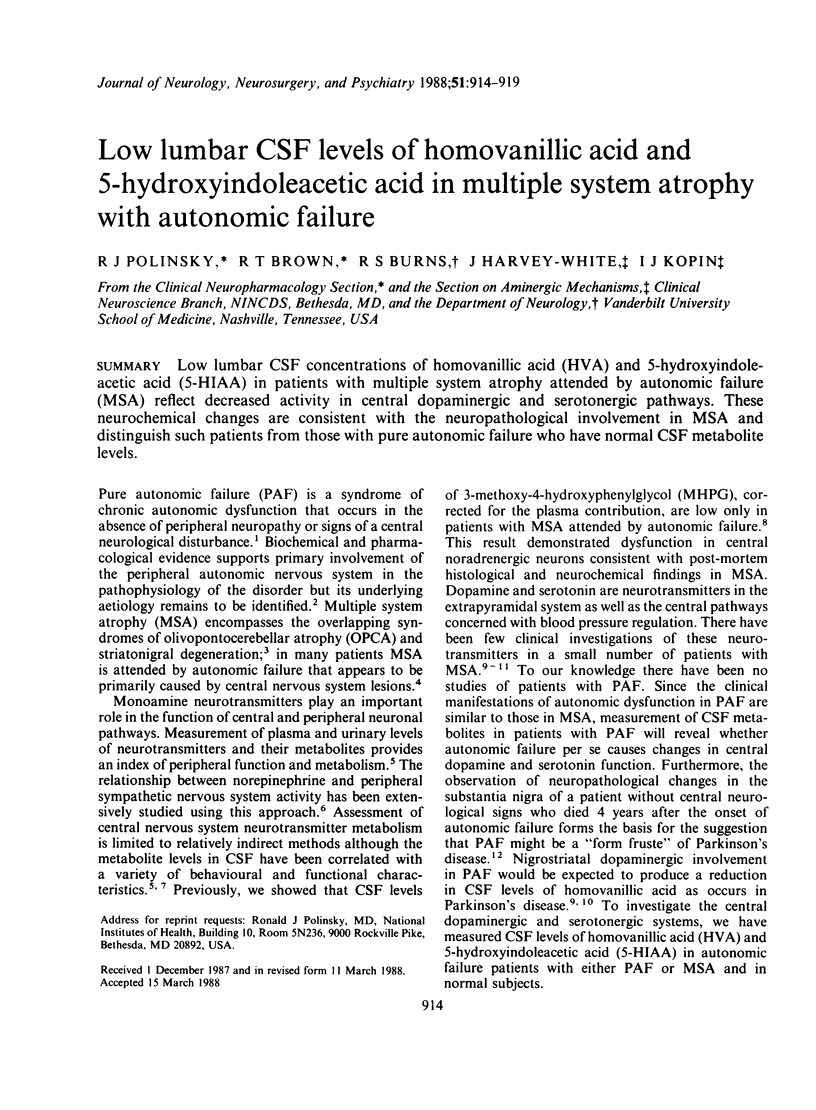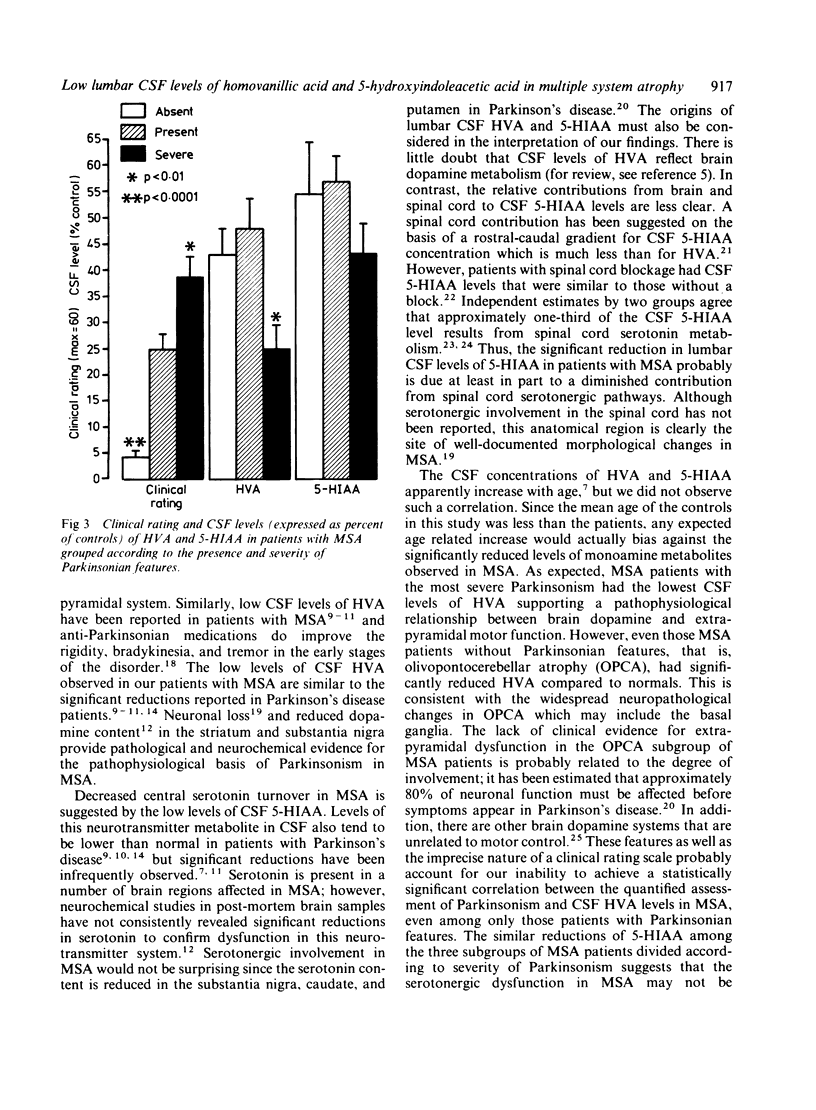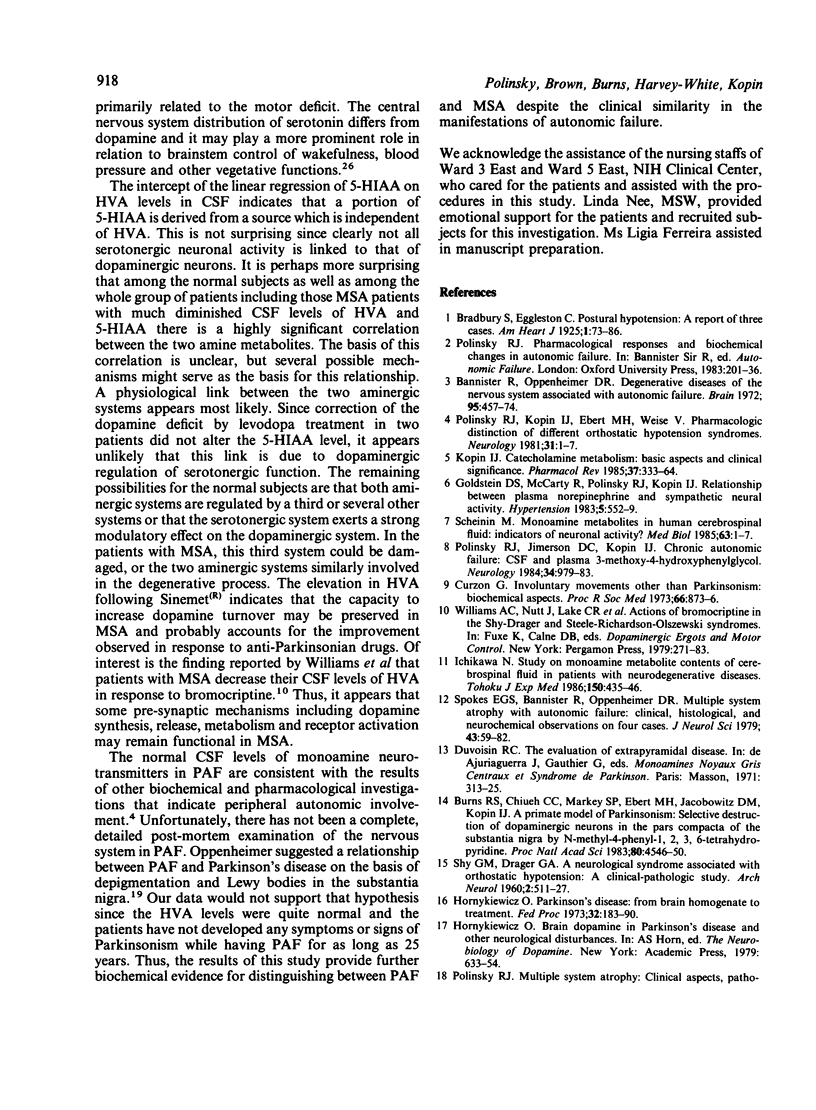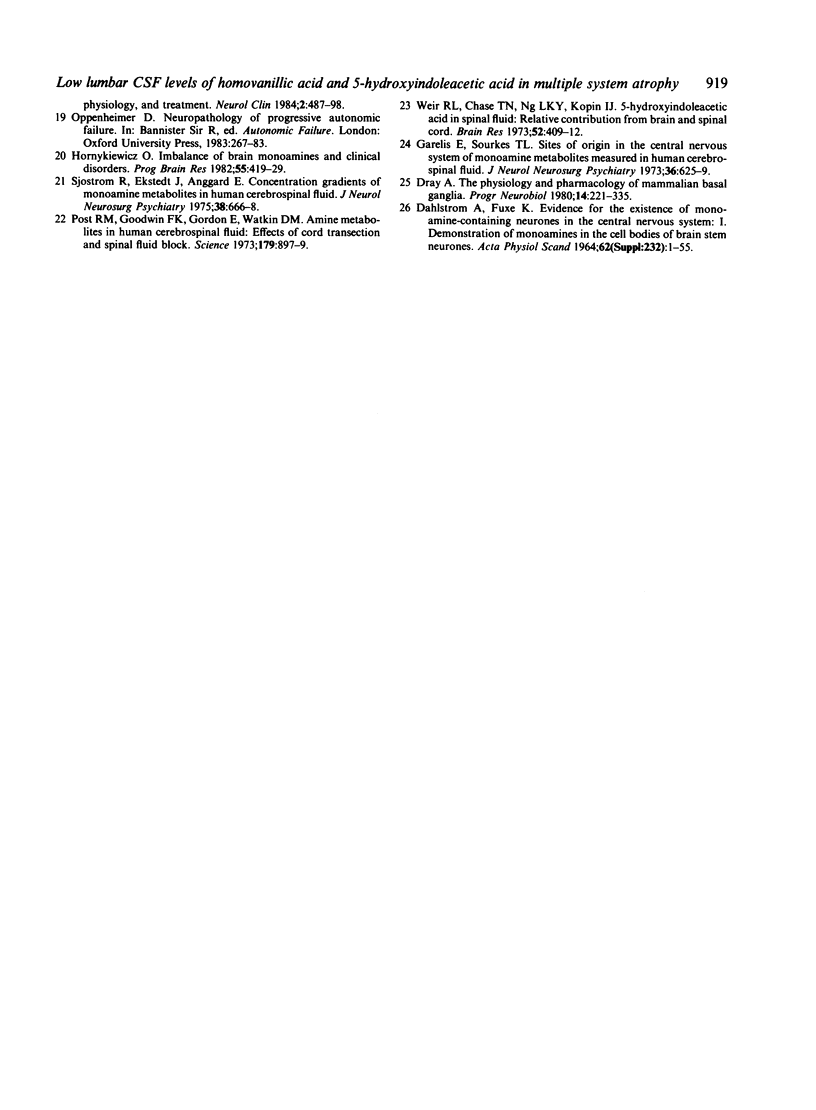Abstract
Low lumbar CSF concentrations of homovanillic acid (HVA) and 5-hydroxyindoleacetic acid (5-HIAA) in patients with multiple system atrophy attended by autonomic failure (MSA) reflect decreased activity in central dopaminergic and serotonergic pathways. These neurochemical changes are consistent with the neuropathological involvement in MSA and distinguish such patients from those with pure autonomic failure who have normal CSF metabolite levels.
Full text
PDF





Selected References
These references are in PubMed. This may not be the complete list of references from this article.
- Bannister R., Oppenheimer D. R. Degenerative diseases of the nervous system associated with autonomic failure. Brain. 1972;95(3):457–474. doi: 10.1093/brain/95.3.457. [DOI] [PubMed] [Google Scholar]
- Burns R. S., Chiueh C. C., Markey S. P., Ebert M. H., Jacobowitz D. M., Kopin I. J. A primate model of parkinsonism: selective destruction of dopaminergic neurons in the pars compacta of the substantia nigra by N-methyl-4-phenyl-1,2,3,6-tetrahydropyridine. Proc Natl Acad Sci U S A. 1983 Jul;80(14):4546–4550. doi: 10.1073/pnas.80.14.4546. [DOI] [PMC free article] [PubMed] [Google Scholar]
- Curzon G. Involuntary movements other than Parkinsonism: biochemical aspects. Proc R Soc Med. 1973 Sep;66(9):873–876. doi: 10.1177/003591577306600921. [DOI] [PMC free article] [PubMed] [Google Scholar]
- Dray A. The physiology and pharmacology of mammalian basal ganglia. Prog Neurobiol. 1980;14(4):221–335. doi: 10.1016/0301-0082(80)90017-9. [DOI] [PubMed] [Google Scholar]
- Garelis E., Sourkes T. L. Sites of origin in the central nervous system of monoamine metabolites measured in human cerebrospinal fluid. J Neurol Neurosurg Psychiatry. 1973 Aug;36(4):625–629. doi: 10.1136/jnnp.36.4.625. [DOI] [PMC free article] [PubMed] [Google Scholar]
- Goldstein D. S., McCarty R., Polinsky R. J., Kopin I. J. Relationship between plasma norepinephrine and sympathetic neural activity. Hypertension. 1983 Jul-Aug;5(4):552–559. doi: 10.1161/01.hyp.5.4.552. [DOI] [PubMed] [Google Scholar]
- Hornykiewicz O. Imbalance of brain monoamines and clinical disorders. Prog Brain Res. 1982;55:419–429. doi: 10.1016/S0079-6123(08)64212-0. [DOI] [PubMed] [Google Scholar]
- Hornykiewicz O. Parkinson's disease: from brain homogenate to treatment. Fed Proc. 1973 Feb;32(2):183–190. [PubMed] [Google Scholar]
- Ichikawa N. Study on monoamine metabolite contents of cerebrospinal fluid in patients with neurodegenerative diseases. Tohoku J Exp Med. 1986 Dec;150(4):435–446. doi: 10.1620/tjem.150.435. [DOI] [PubMed] [Google Scholar]
- JOHANSEN K. REGIONAL DISTRIBUTION OF CIRCULATING BLOOD DURING SUBMERSION ASPHYXIA IN THE DUCK. Acta Physiol Scand. 1964 Sep-Oct;62:1–9. doi: 10.1111/j.1748-1716.1964.tb03945.x. [DOI] [PubMed] [Google Scholar]
- Kopin I. J. Catecholamine metabolism: basic aspects and clinical significance. Pharmacol Rev. 1985 Dec;37(4):333–364. [PubMed] [Google Scholar]
- Polinsky R. J., Jimerson D. C., Kopin I. J. Chronic autonomic failure: CSF and plasma 3-methoxy-4-hydroxyphenylglycol. Neurology. 1984 Jul;34(7):979–983. doi: 10.1212/wnl.34.7.979. [DOI] [PubMed] [Google Scholar]
- Polinsky R. J., Kopin I. J., Ebert M. H., Weise V. Pharmacologic distinction of different orthostatic hypotension syndromes. Neurology. 1981 Jan;31(1):1–7. doi: 10.1212/wnl.31.1.1. [DOI] [PubMed] [Google Scholar]
- Polinsky R. J. Multiple system atrophy. Clinical aspects, pathophysiology, and treatment. Neurol Clin. 1984 Aug;2(3):487–498. [PubMed] [Google Scholar]
- Post R. M., Goodwin F. K., Gordon E., Watkin D. M. Amine metabolites in human cerebrospinal fluid: effects of cord transection and spinal fluid block. Science. 1973 Mar 2;179(4076):897–899. doi: 10.1126/science.179.4076.897. [DOI] [PubMed] [Google Scholar]
- Scheinin M. Monoamine metabolites in human cerebrospinal fluid: indicators of neuronal activity? Med Biol. 1985;63(1):1–17. [PubMed] [Google Scholar]
- Sjöström R., Ekstedt J., Anggård E. Concentration gradients of monoamine metabolites in human cerebrospinal fluid. J Neurol Neurosurg Psychiatry. 1975 Jul;38(7):666–668. doi: 10.1136/jnnp.38.7.666. [DOI] [PMC free article] [PubMed] [Google Scholar]
- Spokes E. G., Bannister R., Oppenheimer D. R. Multiple system atrophy with autonomic failure: clinical, histological and neurochemical observations on four cases. J Neurol Sci. 1979 Sep;43(1):59–82. doi: 10.1016/0022-510x(79)90073-x. [DOI] [PubMed] [Google Scholar]
- Weir R. L., Chase T. N., Ng L. K., Kopin I. J. 5-hydroxyindoleacetic cid in spinal fluid: relative contribution from brain and spinal cord. Brain Res. 1973 Mar 30;52:409–412. doi: 10.1016/0006-8993(73)90682-3. [DOI] [PubMed] [Google Scholar]


